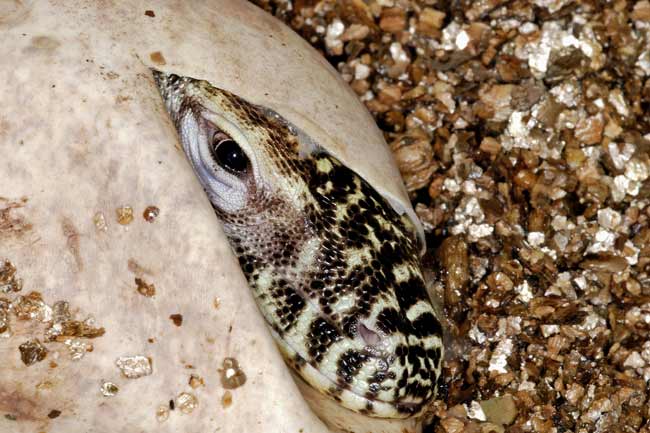Eggs Crack Open in Komodo Dragon's Virgin Births

Five baby Komodo dragons have broken through their shells under the watchful eye of their virgin mom Flora at a zoo in London
Last May, 7-year-old Flora laid a clutch of 25 eggs, 11 of which were viable, at the Chester Zoo. An awestruck team of animal keepers knew almost immediately this was a virgin birth as the female Komodo dragon (Varanus komodoensis) had no prior contact with a male dragon at the zoo.
Scientific results confirmed it. Phillip Watts of Liverpool University performed genetic tests on embryonic material from three collapsed eggs, proving that Flora was both mom and dad.
The single-female reproduction occurred via a process called parthenogenesis, in which an "unfertilized" egg develops to maturity. During cell division, females produce four egg-progenitor cells, only one of which becomes the egg. For Flora, one of her just-forming egg cells acted like a surrogate sperm and fertilized the egg cell.
"Flora is oblivious to the excitement she has caused but we are delighted to say she is now a mum and dad," said Chester Zoo curator Kevin Buley. "When the first of the babies hatched, we didn't know whether to make her a cup of tea or pass her the cigars."
Baby boys
There is no mystery as to whether Flora's hatchlings will be girls or boys. Her no-sex reproduction sealed their fate. Flora's developing clutch will all be male.
Get the world’s most fascinating discoveries delivered straight to your inbox.
For humans, sex is determined by one of the 23 pairs of chromosomes in the nucleus of each of our cells. Females produce eggs with an X chromosome while males generate sperm in which half carry an X and half carry a Y sex chromosome.
In Komodo dragons and some other lizards, females have dissimilar sex chromosomes (Z and W), while males have matching chromosomes (ZZ). Since Flora's cells did all of the fertilization, her offspring will be so-called homozygous individuals. Buley explained that with parthenogenesis, a Z cell will only combine with a Z egg to produce ZZ offspring, while a W cell would lead to WW offspring.
"Because a WW is neither male nor female, those eggs are in-viable. So the only combination that produces viable eggs is ZZ which is male," Buley told LiveScience.
Lizard care
After about an eight-month incubation period, Flora's eggs began to hatch. The first baby started to emerge on Jan. 15, with the next wee ones breaking out on the 17th, 18th, 21st and 22nd. The lizard tots measure about 17 inches in length and weigh 4 ounces each--larger than many full grown adult lizards. Two fertile eggs still remain in an incubator and could hatch any day.
The five new additions are feeding on a diet of crickets and locusts. As for names, the jury's still out, said Buley. Komodos can live for more than 40 years, he said, so their names have to be just as evergreen.
Currently black and yellow, the new dragons will eventually lose their bright coloring as they grow into adults--which can reach a record-breaking 10 feet in length and tip the scales at about 200 pounds.
- Top Ten Unexplained Phenomenon
- Mating Game: The Really Wild Animal Kingdom
- The Sex Quiz: Myths, Taboos and Bizarre Facts
- Images: Snakes, Frogs and Lizards
Jeanna Bryner is managing editor of Scientific American. Previously she was editor in chief of Live Science and, prior to that, an editor at Scholastic's Science World magazine. Bryner has an English degree from Salisbury University, a master's degree in biogeochemistry and environmental sciences from the University of Maryland and a graduate science journalism degree from New York University. She has worked as a biologist in Florida, where she monitored wetlands and did field surveys for endangered species, including the gorgeous Florida Scrub Jay. She also received an ocean sciences journalism fellowship from the Woods Hole Oceanographic Institution. She is a firm believer that science is for everyone and that just about everything can be viewed through the lens of science.


